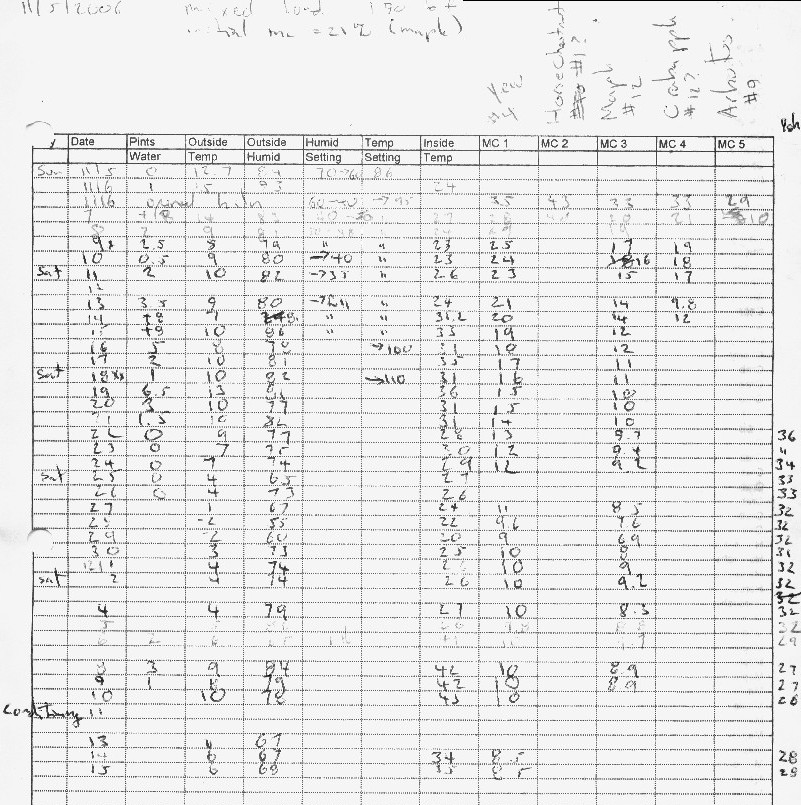Question
I recently picked up a back issue of American Woodworker, #94 June 2002, that has a good article on constructing a simple DH kiln. I have constructed a kiln using these plans. It uses a simple humidistat to control the dehumidifier, and a remote bulb thermostat to control the heater, which is a couple of light bulbs.
Ignoring for a moment the merits of a homebrew DH kiln versus a Nyle, I was curious to see that rather than referencing the standard kiln schedules (e.g. T8-C3 or similar for hard maple), the article instead provided a table showing the "safe drying rates" (SDR) for a number of species. For 4/4 hard maple, with an initial temperature of 90F and an initial relative humidity of 81%, the SDR was given as .0061 pints per hour per board foot. So, if you have 100 bf in the kiln, every 12 hours you would extract (12 hours *100bf * .0061 SDR) = 7.3 pints of water. Basically the idea seems to be to maintain a constant temperature, and to keep lowering the humidistat to maintain the SDR until the moisture content gets to the desired level. Seems like a pretty simple way to run the kiln - once or twice a day just measure the amount of water extracted, and turn down the humidity a bit as needed.
So, with that lengthy introduction, here is my question. How do I convert from the standard kiln schedules in the USDA's "Dry Kiln Schedules for Commercial Woods" and "Drying Hardwood Lumber" to an SDR-type schedule?
I am also curious why an initial temperature of 90F would have been selected. I'd like to know for my own curiosity, as well as to be able to generate SDR schedules for other species not given in the American Woodworker article, like the 6 foot long 24" wide slabs of 8/4 madrone I got this summer. Not bragging or anything!
Forum Responses
(Sawing and Drying Forum)
From contributor D:
It is a meaningless exercise to try to convert those schedules for the kiln you built. They are based on different air flow rates, etc. There is a way to do the conversions and there is a chart published by Nyle to do it, if you want to do some academic exercise. The conversion method described in the Dry Kiln Operator's Manual is not really accurate, but it is safe. The approach described in the article where you try to keep the water leaving at a steady rate is fine. There might be a problem with that if the chamber overheats and has to be vented because some water will leave that way. Also, for that approach to work, the chamber needs to be air tight.
My question focuses on the initial relative humidity featured in the Safe Drying Rate table. With each load I did not have the initial relative humidity rate. The first load was started with 60% and this load was started with 78%. Although I can maintain the 90 degree temperature, I could not start at the recommended humidity level unless I added humidity. Should I? I am removing water about 50% below the SDR. Would adding humidity at the start, bringing the initial relative humidity rate to 87% as suggested in the table, result in better product or faster drying?
Also, you can't really control well by measuring the collected water because some of the water leaks out with vented or leaking air. I know your kiln is absolutely tight and perfectly sealed, but it has to vent some or it would overheat. If it isn't overheating, it is leaking.
You won't ever have the fastest kiln in town, but it can still work. I don't remember how the air flow was arranged in the kiln in the magazine, but it sounds like that could be a problem for you.
At the end of the cycle I have the opposite problem. As the MC drops and I crank the DH on more and more, the temp tends to rise up too high just from the heat the DH throws off, even though the light bulb heaters are not on at that point. I'm thinking I could vent it manually, but with the RH so high externally I am not sure if that is the right thing to do.
I guess I am thinking that while I am seeing the wood's MC and the kiln's RH drop smoothly, the fact that the temperature jumps around a bit may mean that the drying rates are hard to control, hence my loss of horse chestnut.
Anyway, I included my log of a load I did in Nov '06 for everyone's amusement. Temps are in Celsius (20C = 70F, 40C = 105F). I know mixed loads are taboo, but this one worked well, other than the horse chestnut. The column on the right I added part way through is the kiln's internal RH. I modified one of the Radio Shack combo units so it could measure the RH remotely as well as the temp.
